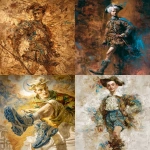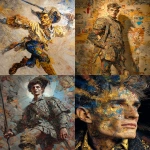Explore the Best AI Image Gallery

The Fabric of Innovation: How 5G is Weaving a New Tapestry for Creativity
The landscape of creativity is perpetually evolving, shaped by technological advancements that push the boundaries of artistic expression. Today, 5G technology stands at the forefront of this evolution, poised to revolutionize how we create, consume, and interact with art and design.
With its unprecedented speed, low latency, and massive connectivity capabilities, 5G is not merely an upgrade; its a fundamental shift in the creative paradigm. Imagine artists wielding haptic gloves that translate their movements into real-time, immersive sculptures, or musicians composing symphonies using AI-powered algorithms that respond to their emotions.
Unleashing the Potential: 5G Use Cases in the Creative Industry
- Immersive Experiences: 5G enables ultra-realistic augmented and virtual reality (AR/VR) experiences, blurring the lines between the physical and digital worlds. Artists can create interactive installations that respond to viewers movements, or designers can showcase products in immersive 3D environments.
- Real-Time Collaboration: 5G facilitates seamless collaboration across geographical boundaries. Creative teams can work together on projects in real-time, regardless of their location, fostering a more connected and dynamic creative process.
- AI-Powered Creativity: 5Gs high bandwidth allows for the processing of vast amounts of data, enabling AI algorithms to assist artists in generating novel ideas, composing music, or even creating original artwork. This opens up exciting possibilities for exploring the intersection of human creativity and artificial intelligence.
- Personalized Content: 5G empowers creators to deliver highly personalized content tailored to individual preferences. Imagine attending a concert where the music dynamically adapts to your mood or viewing an art exhibition where the displayed pieces are curated based on your tastes.
Navigating the Ethical Landscape
As with any transformative technology, 5Gs impact on the creative industry raises ethical considerations that must be addressed thoughtfully.
- Data Privacy and Security: The massive data generated by 5G-enabled applications requires robust privacy and security measures to protect user information from breaches and misuse.
- Algorithmic Bias: AI algorithms used in creative tools can perpetuate existing biases if not carefully designed and monitored. Its crucial to ensure that these algorithms are fair, transparent, and accountable.
- Access and Equity: 5G technology requires significant infrastructure investment, which may create disparities in access for certain communities or individuals. Efforts should be made to bridge the digital divide and ensure equitable access to 5Gs benefits.
The Future of Creativity: A 5G-Powered Canvas
The future of creativity is inextricably linked to the evolution of 5G technology. As 5G networks become more widespread and sophisticated, we can anticipate a surge in innovative applications that will reshape the creative landscape.
- Hyper-realistic Avatars: Imagine attending virtual conferences where participants interact as highly realistic digital avatars, blurring the lines between physical presence and online interaction.
- Smart Materials: 5G will enable the development of smart materials that respond to stimuli, opening up new possibilities for interactive sculptures, responsive architecture, and fashion that adapts to its wearer.
- Immersive Storytelling: 5G-powered AR/VR experiences will revolutionize storytelling, allowing audiences to immerse themselves in narratives and engage with characters and environments on a deeper level.
The fabric of innovation is being woven with the threads of 5G technology. As artists, designers, and technologists embrace this transformative power, we can expect a future where creativity knows no bounds and imagination takes flight in unprecedented ways.


](https://images.ai-img.art/thumbnails/150/8c3bd422d50d35735d8fb33bd314a79e30e5b150129d5d09bdad822a2007593f.webp)
](https://images.ai-img.art/thumbnails/150/3a60737a5b67fa252207ad1ae6db245a26284f53fb5846996bb34515b39ff269.webp)




](https://images.ai-img.art/thumbnails/150/1614d64dd7156c95db952258978be809eb3db8cea4453fec69c49cbdfe63fa94.webp)



